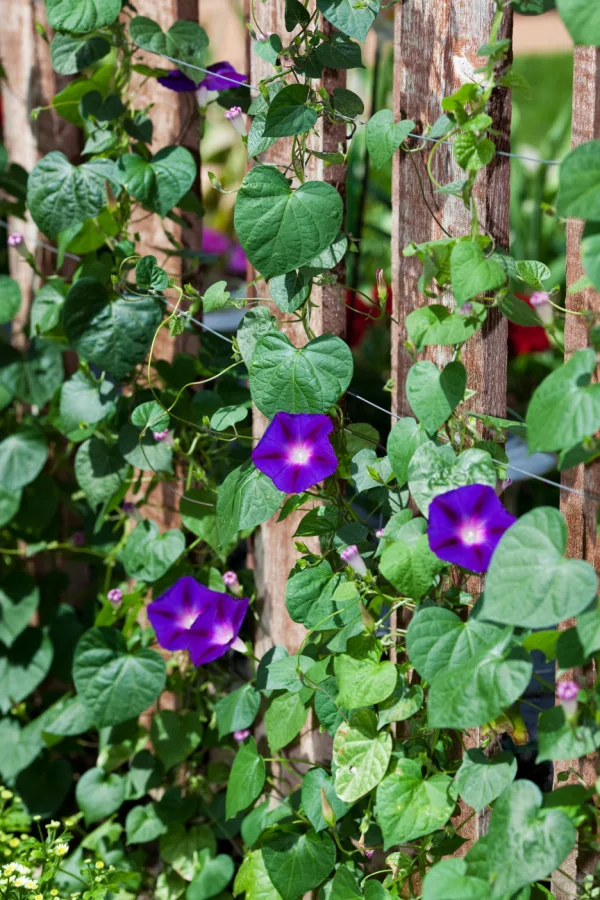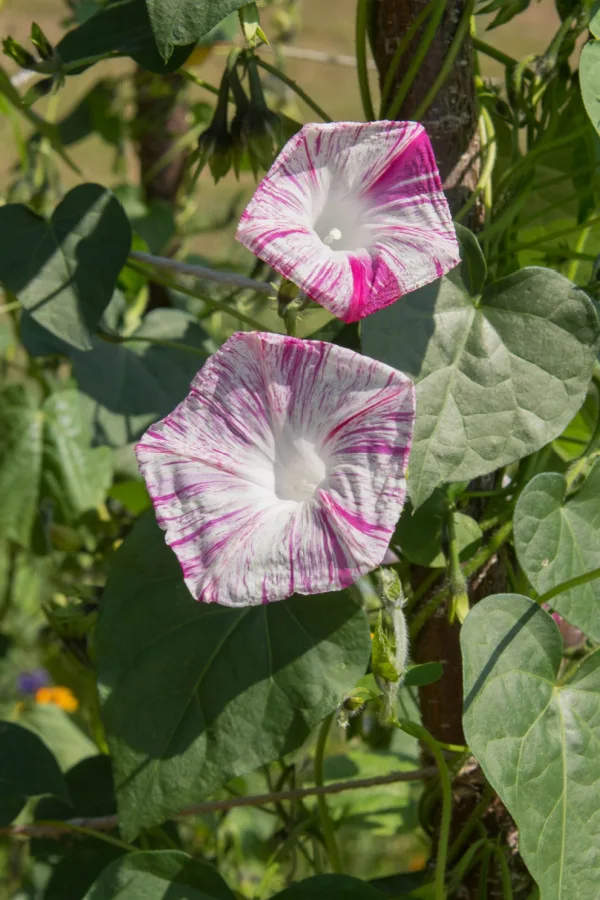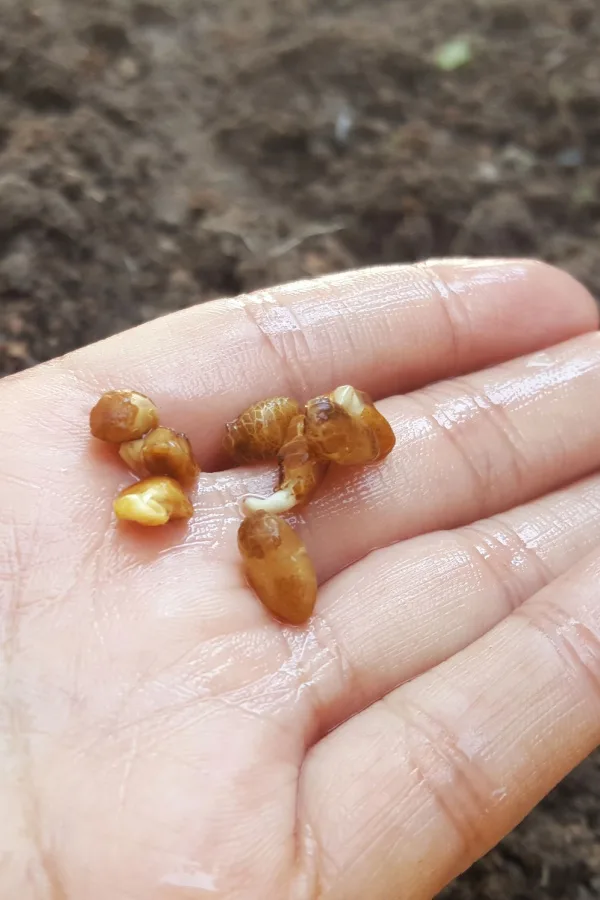If you want to add consistent colorful blooms and vertical visual interest to your property, then growing morning glory vines is the way to go!
Morning glories are a perfect drought-tolerant climbing annual that are great for adding beautiful blooms and foliage to your landscape. While a few varieties do fall under the invasive weed category, most are a welcoming site to homes and garden areas.
They feature heart-shaped leaves with trumpet-like blooms in purples, reds, pink, white, and even blue-like colors. Their bright blooms are also perfect for attracting hummingbirds and butterflies alike.

Morning glory vines look almost magical growing up a garden entryway arch or trailing off a wooden pergola above your patio set. Even a simple fence line can benefit from their plentiful blooms.
Adding to their beauty, morning glory vines are basically maintenance-free. It really does give you a perfect combination of color and ease! With that said, there are a few basic things to keep in mind if you want to add them to your property this year.
Varieties of Morning Glories – Growing Morning Glory Vines
“Morning Glory” is a common name for over 1,000 different species of flowering plants. They get their name from the fact that their trumpet-like blooms open during the morning hours. When the sunlight hits them, they open, and then close again in the afternoon early evening shade.
Different morning glory varieties have different hardiness zones. It’s important, as mentioned earlier, to keep in mind that some morning glories are considered invasive in some states. Doing a little background research to ensure you can enjoy your flowering plant instead of fighting them in the future is always a good idea.
Good Morning Varieties To Try…
One great variety to try is Inkspot. It is a fast-growing vining morning glory variety that produces violet and white blooms. For more unique blooms, check out the Harlequin Mix. It produces bi-colored striped blooms in whites, purples, blues, and pinks.

If you don’t have the space for large vining plants, consider more of a mounding morning glory variety such as Dwarf Mixed varieties. You still get the beauty of traditional morning glories without extensive growth.
How To Plant, Grow, And Maintain Morning Glory Vines
Planting Morning Glory Vines – Growing Morning Glory Vines
Preparing Seeds
You can start morning glory vines indoors or directly sow outdoors depending on your climate and location. Whichever method you choose, you will need to prepare the seeds a bit before planting.
Morning glory seeds have a very hard outer seed coat. Because of this, the seeds should be carefully roughed up or cut slightly and then soaked overnight in water before sowing. In the morning, your seeds will be all ready to go into your seed-starting soil or directly into the ground.
Sowing Seeds
If starting your morning glory seeds indoors, plan on sowing seeds about four to six weeks before your last spring frost date. Be sure to select a good quality seed-starting soil along with trays or containers that have plenty of drainage holes. Plant seeds about a quarter of an inch deep and lightly cover with soil. Once seeds germinate, keep plants under lights until they are ready to go outdoors.
When planting outdoors, choose a location that receives full sun. Specifically morning sun when possible. This allows those “morning” blooms to open as their namesake implies. Also, pick a location that is out of the wind if you plan on trellising.

When planting outside, the type of soil isn’t as important since morning glories can thrive in poor soils. In fact, overly fertile soil can produce an abundance of foliage as opposed to blooms. Just ensure that the soil is around 65º Fahrenheit if you are planting seeds directly. For transplants, make sure the threat of frost is over.
Sow the seeds about one-half inch deep and about six to twelve inches apart. If you are trellising your plants, you can space them a bit closer than those left as ground cover plants. Backfill with additional soil and water the plants in well after planting. Germination usually takes around a week or two.
Planting Transplants
When the soil has warmed to the correct temperature, it is time to transplant your indoor started seedlings outside. Be sure to harden off the plants prior to planting outside. Again, it is important to select a location that receives full sun and is out of the wind.
Long-Term Care – How To Grow and Maintain Morning Glory Vines
Trellising
When plants are around six to twelve inches tall, it’s time to start training them up your trellis or support structure. Use jute string, cotton yarn, or some other sort of soft string to tie the stems to your supports.
Every week or two, check plants to ensure that the vines are starting to climb on their own. If they aren’t, continue to give them a helping hand by trying up vines as needed. They will eventually find their way on and cling better as they mature.
Watering
While morning glory vines are drought tolerant, still try to give them about 1 inch of water every week while they are developing early on. If Mother Nature is not providing enough early in their lifecycle, it can affect growth and future bloom sets.

Water in the early morning at the base of plants and avoid watering at night. Keep in mind you will need to water morning glory vines growing in containers and pots more often, especially during warmer and drier than normal spells.
Mulching
Adding mulch around the base of plants will help to retain moisture as well as keep the soil temperatures regulated. A natural much like shredded leaves, straw, grass clippings, or even wood chips also helps to keep weeds at bay. Just don’t allow the mulch to touch the stems.
Reseeding
You don’t have to deadhead spent blooms, but doing so will help to prevent plants from naturally reseeding. Just be sure to cut off the blooms before they turn into seedpods. This will also help to encourage the plants to keep producing blooms throughout the growing season.
Plants may reseed themselves when left to go to seed, but it isn’t always a guarantee. Just in case, be sure to place plants in a location where you want the morning glory vines to stick around for a few years.
Pests & Issues
Thankfully, morning glory vines aren’t affected by many pests and diseases like some other flowering annuals can be. However, there are still a few issues to watch out for. Your typical garden pests like aphids and leaf miners will sometimes become an issue. If you start to see signs of pests, spray off the aphids or use an organic spray such as neem oil to control infestations.

Side Note Warning
Please keep in mind that morning glory plants are poisonous and should be kept away from pets and small children. They are especially hazardous when consumed in large quantities.
Also, when purchasing seeds, don’t confuse morning glories with the invasive perennial Field Bindweed (sometimes called Creeping Jenny). It looks and grows similarly to morning glories but produces deep roots that allow it to overwinter. Those deep roots can make it hard to eradicate.
Here is to planting and growing morning glories in your landscape this year. They can be a perfect way to add height and beautiful color from May all the way through the fall season!
Follow Our Facebook Page For Even More Great Tips! Simple Garden Life Facebook Page
Simple Garden Life is a website dedicated to keeping gardening fun, simple and enjoyable! We publish two new articles each week along with a new garden podcast episode every two weeks. This article may contain affiliate links.
Feel free to download, print out, or save our Morning Glory Vines At-A-Glance sheet. It is sized for half letter printing but can be scaled if needed.
